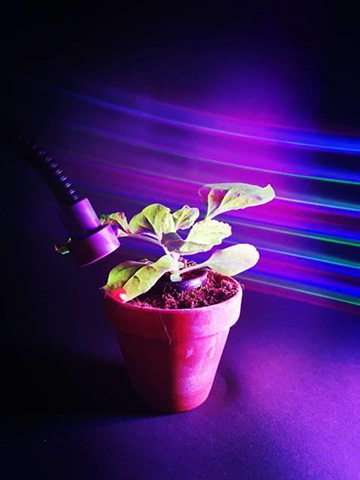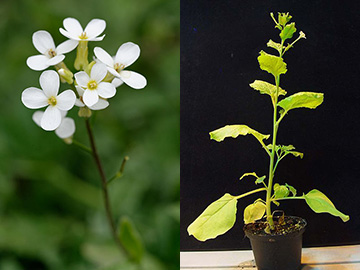
[Image: Leonie-Alexa Koch, Institute of Synthetic Biology, University of Düsseldorf]
The technology of optogenetics has revolutionized some key areas of mammalian biology, particularly the study of the brain, by allowing control of individual cells using pulses of light. Plant biologists would like to get in on the action as well. But there’s been a problem: Plants are hard-wired to grow in white light—so any genetically encoded switch designed to be tripped by visible light would be active all the time.
Now, a team of scientists in Germany and the United Kingdom has found an end-run around the problem, which allows gene expression to be tweaked using narrowband red light but keeps the switch suppressed in white light (Nat. Methods, doi: 10.1038/s41592-020-0868-y). The researchers believe that the method, dubbed PULSE (Plant-Usable Light-Switch Elements), could offer a new optogenetic control knob for studying plants and even for improving their yields and defenses against pathogens.
The white-light blues
Optogenetics involves genetic modification of laboratory animals, such as mice, to express light-sensitive proteins in certain cells; those proteins then become switches that allow control of cellular activity with light pulses, piped in wirelessly or via fiber optics. The classic example is channelrhodopsin, a photosensitive protein derived from algae. When introduced into nerve cells using the techniques of gene therapy, the protein can be used to open neuronal ion channels, and thus cause individual neurons to fire, with the application of blue light.
Studies with channelrhodopsin and other light-sensitive proteins have, in the past two decades, opened vast new capabilities for mapping brain activity (see “Optogenetics,” OPN, April 2018). Optogenetics has even recently been extended to studies and control of other tissues, such as the cardiovascular system.
For using optogenetics in the plant kingdom, however, there’s a problem. Plants, almost by definition, require white light, the engine of photosynthesis, to grow and thrive. And, since white light contains all visible wavelengths, any light-switch protein activated by a specific color of light would be in the “on” position all the time—making it effectively useless.
On in red, off in white
To get around that quandary, the researchers behind the new work—including scientists at the University of Düsseldorf and the University of Freiburg, Germany, and the University of East Anglia and the University of Glasgow, U.K.—looked at putting two light-activated switches together to allow the control of gene expression in plants.
Specifically, the PULSE system consists of two genetically engineered photoreceptors—one that turns off, or represses, the expression of a specific gene under the application of blue light, and another that turns on gene expression with the application red light within a narrow wavelength band. The two switches are introduced into the gene sequence as module, such that the presence of any blue light will always shut down expression of the gene.
What that means is that, in the presence of ordinary white light—which includes both blue and red wavelengths—the system will be set to “off,” as the blue-light component will repress expression of the target gene. In the presence of monochromatic red light of the right wavelength, however, gene expression is turned on. (In darkness, the gene remains switched off, since it requires red light to be turned on.)
Controlling immune responses
“We can now use a red light to cause gene expression at a precise moment, while an ambient white light can be used as an ‘off switch’ to reverse the process,” study coauthor Ben Miller of the University of East Anglia noted in a press release accompanying the work. “This can be repeated any number of times.”

The team tested out its optogenetic tool on two common model organisms, Arabidopsis thaliana (left) and Nicotiana benthamiana (right). [Images: © Marie-Lan Nguyen/Wikimedia Commons/CC-BY 2.5 (left); Wikimedia Commons (right)]
The team has already performed experiments combining the PULSE system with CRISPR-Cas9 gene-editing technology in two common plant model organisms, the thale cress Arabidopsis thaliana and the tobacco relative Nicotiana benthamiana. The researchers were able to use the switch to control immune responses in individual plant leaves, and even created transgenic versions of A. thaliana including the switch, opening up avenues for all-plant control.
Advantages over chemistry and drugs
Miller notes that these light-based genetic switches open up substantial new possibilities in plant biotechnology—especially as the use of light is “far less invasive and more reversible” than the chemicals or drug treatments usually used to control biological processes.
“We have shown that plant immune responses can be switched on and off using our light-controlled system,” he says. “If this system was used in crops, we could potentially improve plant defenses to pathogens and have an impact by improving yields.” And, as the system is further developed, the researchers write that it could facilitate study and manipulation of plant processes including development, growth, hormone signaling and stress responses.
“It’s a really exciting new tool,” according to Miller, “for us to answer fundamental questions in plant biology.”
